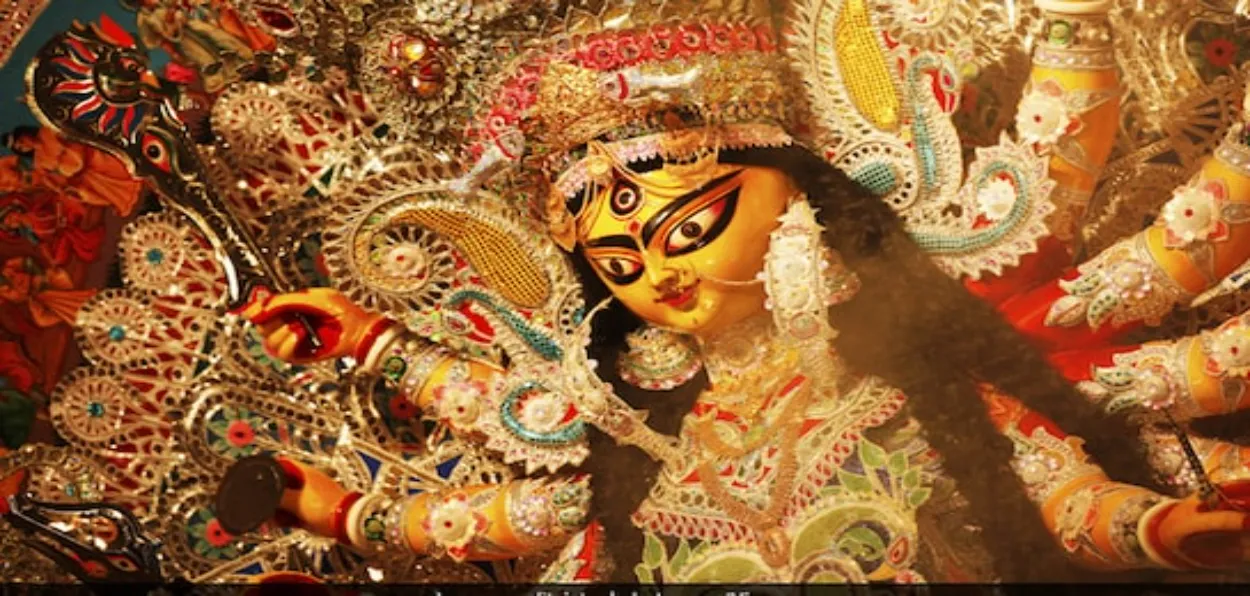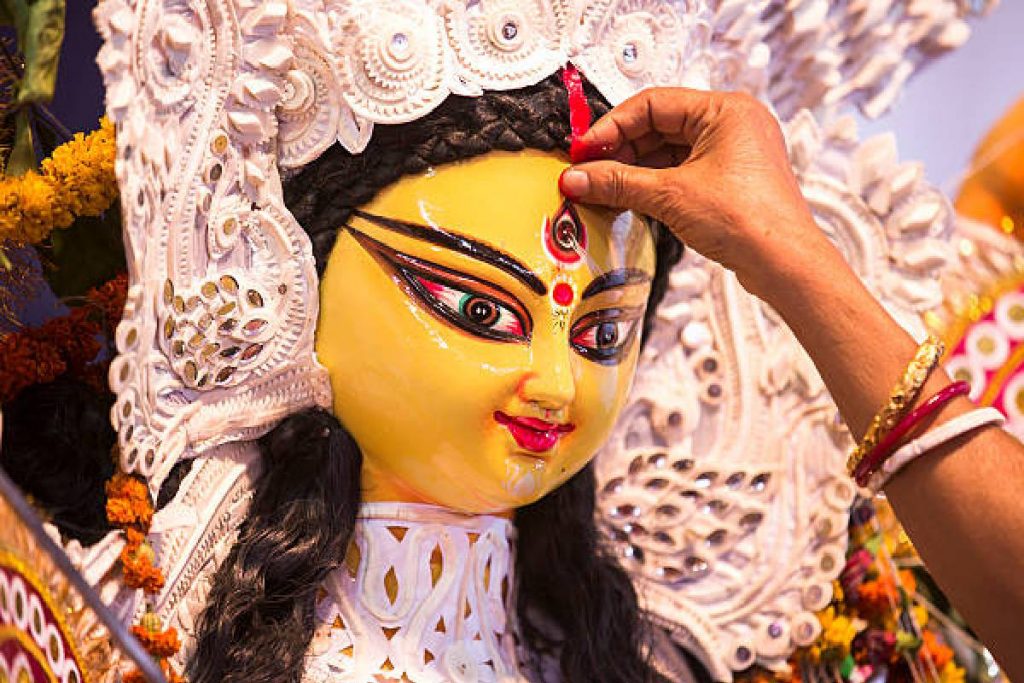
Pallab Bhattacharyya
In the golden embrace of autumn, when the air carries whispers of approaching festivities and the heart yearns for divine communion, one of humanity's most magnificent celebrations unfolds—Durga Puja. This sacred festival, transcending the boundaries of mere religious observance, emerges as a spectacular confluence of devotion, artistry, and cultural renaissance that has captured the imagination of millions worldwide.
Durga Puja finds its celestial timing in the Hindu lunar month of Ashvin, gracefully corresponding to September-October in the Gregorian calendar. In 2025, this divine celebration will commence with Mahalaya on September 21, marking the beginning of Goddess Durga's journey from her celestial abode at Mount Kailash to her earthly maternal home. The actual festivities unfold over five magnificent days: Maha Shashthi on September 28, Maha Saptami on September 29, Maha Ashtami on September 30, Maha Navami on October 1, and culminating in Vijaya Dashami on October 2.
The mythological tapestry that weaves through Durga Puja finds its origins in the ancient Hindu text, the Devi Mahatmya, composed between the 5th and 6th centuries CE.
According to this sacred narrative, the universe once trembled under the tyrannical rule of Mahishasura, a powerful demon who had received a divine boon that no man or god could destroy him. When his reign of terror threatened the very fabric of existence, the trinity of Brahma, Vishnu, and Shiva combined their divine energies to create Durga—a warrior goddess whose ten arms bore the collective power of all the gods. After ten days of fierce battle, Durga emerged victorious, beheading Mahishasura and restoring cosmic order, thus establishing the eternal triumph of good over evil.
Yet another layer of significance emerges through the myth of “akalbodhan”, where Prince Rama invoked Goddess Durga during his battle against Ravana, marking this as a period of special divine accessibility. This connection to the Ramayana adds profound depth to the festival's spiritual significance, establishing it as a celebration of righteousness prevailing over darkness.

The image of Maa Durga killing Mahishasura
The communities that embrace Durga Puja with fervent devotion primarily include Bengali Hindus, for whom this festival represents the very essence of their cultural identity. While originating in West Bengal, the celebration has spread its wings across Indian states, including Tripura, Assam, Odisha, Bihar, Jharkhand, eastern Uttar Pradesh, Gujarat, Tamil Nadu, Punjab, Andhra Pradesh, Chhattisgarh, Karnataka, Maharashtra, and Himachal Pradesh. Each region adds its unique cultural flavour while maintaining the festival's spiritual core.
The five days of Durga Puja each carry distinct spiritual and ritualistic significance that transforms the ordinary into the sacred. Maha Shashthi marks the divine awakening through the ceremony of Bodhon, where Goddess Durga is formally invoked to descend to earth, accompanied by the painting of eyes on her idol in the sacred ritual of Chokkhu Daan. The rhythmic beats of dhak drums and the fragrant dhunuchi dance fill the air with divine energy, announcing the goddess's arrival.
Maha Saptami witnesses the enchanting ritual of Nabapatrika Snan, where nine sacred plants, represented primarily by a banana tree called Kola Bou, are bathed in holy water and draped in a red-bordered sari. This ritual symbolizes the divine feminine energy manifest in nature's bounty and agricultural abundance, connecting the spiritual realm with earthly sustenance.
The intensity reaches its crescendo on Maha Ashtami, the day when Durga's victory over Mahishasura is most powerfully commemorated. This day features the sacred Kumari Puja, where young girls are worshipped as embodiments of the divine feminine, followed by the mystical Sandhi Puja performed at the exact transition moment between Ashtami and Navami—believed to be when Durga struck the final blow against evil.
Maha Navami continues the spiritual momentum with elaborate Maha Aarti ceremonies, where thousands gather to witness the divine light of countless oil lamps creating a celestial atmosphere of devotion. The air resonates with sacred chants and the collective prayers of devotees seeking the goddess's blessings for strength, wisdom, and prosperity.
The festival concludes with Vijaya Dashami, a bittersweet celebration that combines joy for the goddess's victory with sorrow for her departure. The day features Sindoor Khela, where married women apply vermillion to each other and to the goddess, followed by the emotionally charged Visarjan ceremony, where the beautifully crafted idols are immersed in rivers, symbolizing the goddess's return to her celestial abode.
The pantheon of deities worshipped during Durga Puja creates a divine family portrait that touches every aspect of human aspiration. Goddess Durga stands at the centre in her ten-armed magnificence, mounted on a lion, with her divine children flanking her sides. To her right are positioned Lord Ganesha, the remover of obstacles and patron of new beginnings, and Goddess Lakshmi, the bestower of wealth and prosperity. On her left stand Goddess Saraswati, the embodiment of knowledge and arts, and Lord Kartikeya, the divine warrior representing courage and victory. This sacred arrangement represents the complete spectrum of divine blessings—wisdom, prosperity, courage, and spiritual protection.
The presence of Lord Shiva, often depicted observing from above, represents the eternal cosmic balance, while the inclusion of other deities like Lord Rama and Hanuman in some pandals connects the celebration to broader Hindu spiritual traditions. Each deity serves a specific purpose: Ganesha ensures obstacle-free worship, Lakshmi brings material well-being, Saraswati bestows knowledge and creativity, and Kartikeya provides strength and valour.

Maa Durga
The social, cultural, and economic significance of Durga Puja extends far beyond its religious boundaries, creating what scholars term the "Durga Puja economy" that contributes approximately 2.5-3% to West Bengal's annual GDP. The 2019 British Council study estimated the festival's economic impact at approximately ₹32,377 crore, demonstrating its massive financial footprint. This economic ecosystem encompasses multiple sectors: retail businesses experience 25-30% of their annual revenue during the festival period, the hospitality industry generates approximately ₹1,200 crore, and the artisan community, centered in Kumortuli, supports nearly 50,000 craftsmen and their families.
The cultural significance resonates even more profoundly, as UNESCO recognized Kolkata's Durga Puja as an Intangible Cultural Heritage of Humanity in December 2021. This recognition acknowledges the festival's role in sustaining traditional arts and crafts, promoting community well-being, and fostering creativity across social boundaries. The festival serves as a bridge between diverse communities, where "divides of class, religion, and ethnicities collapse as crowds of spectators walk around to admire the installations".
The artisanal tradition centered in Kumortuli represents centuries-old craftsmanship, where families have passed down the sacred art of idol-making for over 300 years. These artisans, descendants of craftsmen who migrated from Dhaka during the Mughal period, use clay from the sacred Ganges River mixed with traditional techniques to create divine forms that inspire millions. The process involves multiple stages, from creating the bamboo and wooden framework (kathamo) to applying layers of clay and finally painting and decorating the idols with meticulous attention to detail.
Durga Puja's global footprint extends far beyond India's borders, carried by the Bengali diaspora to numerous countries where it maintains its spiritual essence while adapting to local contexts. In Bangladesh, home to the world's second-largest Bengali Hindu population, the festival is celebrated as a national holiday with elaborate pandals across every city and district. Nepal celebrates it as Dashain, a ten-day festival where the monarchy plays a ceremonial role and entire public institutions close to allow family reunions.
The United Kingdom witnesses authentic Bengali celebrations where Indian communities import idols from Kolkata and recreate traditional pandal experiences, complete with cultural performances and community gatherings. In the United States, particularly in cities with significant Bengali populations, weekend celebrations replace the traditional five-day format due to work constraints, yet maintain the spiritual core through adapted rituals and community meals.
Countries like Germany, France, Italy, Malaysia, Singapore, Russia, and the UAE host vibrant celebrations organized by Bengali associations. These international observances often feature idols shipped from Kumortuli, cultural performances by artists from India and Bangladesh, and adapted rituals that accommodate local regulations while preserving spiritual authenticity. The celebrations serve as cultural anchors for diaspora communities, maintaining connections to ancestral traditions while fostering cross-cultural understanding in their adopted homelands.
The festival's transformation from private aristocratic celebrations in the 18th century to today's massive public spectacle reflects Bengali society's democratic evolution. What began as exclusive zamindar family pujas has evolved into inclusive community celebrations where organizing committees democratically plan and execute festivities that welcome people regardless of religious or social background. Modern Durga Puja has embraced technology and contemporary themes while maintaining traditional spiritual elements, creating a unique synthesis of ancient wisdom and modern expression.
The environmental consciousness embedded in traditional practices finds new relevance today, as the use of biodegradable clay from the Ganges and the ritual of returning idols to water bodies through Visarjan represent an early model of sustainable celebration. This cyclical process—taking from nature and returning to nature—embodies ecological wisdom that resonates strongly with contemporary environmental awareness.
The festival's role as a catalyst for social change continues to evolve, with many pandals using their platforms to address social issues, promote women's empowerment, and celebrate cultural diversity. The tradition of welcoming married daughters back to their parental homes during the festival reinforces family bonds while symbolically representing the goddess's own homecoming.
In the contemporary digital age, Durga Puja has embraced technology while maintaining its traditional soul. Social media platforms buzz with festival photos, virtual pandal tours connect global audiences, and online streaming brings celebrations to devotees worldwide. Yet the essential human elements—community gathering, artistic appreciation, and spiritual devotion—remain unchanged, proving the festival's timeless relevance.
The festival serves as an annual reminder of the divine feminine principle's power to create, protect, and transform. In an era when women's rights and empowerment occupy central positions in global discourse, Durga Puja's celebration of Shakti—divine feminine energy—provides both inspiration and cultural validation for gender equality movements. The goddess's multifaceted representation as daughter, mother, and warrior offers diverse models of feminine strength that transcend cultural boundaries.
As Durga Puja continues to evolve while maintaining its spiritual core, it stands as a testament to cultural resilience and adaptability. The festival demonstrates how ancient traditions can remain vibrantly relevant, fostering community bonds, supporting economic ecosystems, preserving artistic heritage, and providing spiritual sustenance to millions across the globe.
ALSO READ: Shakir Ali revived the miniature painting art of Rajasthan
"The Puja signifies the triumph of good over evil, the celebration of life and the spirit of community" - as the great poet Rabindranath Tagore beautifully captured the essence of this magnificent festival, reminding us that in celebrating the divine feminine, we celebrate the eternal victory of light over darkness, love over hatred, and hope over despair.
